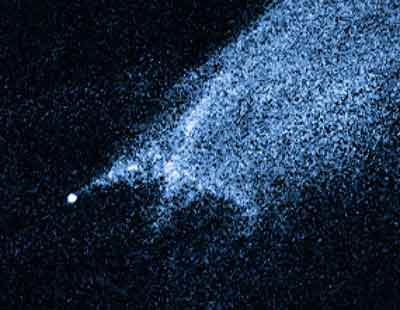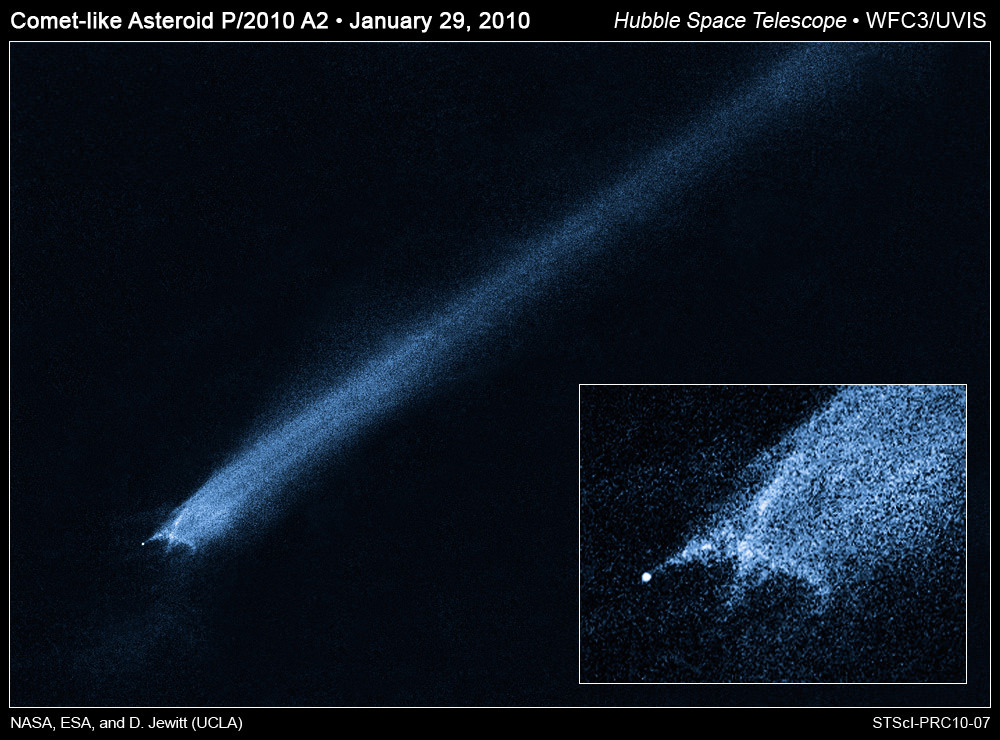[/caption]
We reported earlier that on January 6, 2010, ground-based observatories may have spotted evidence of an asteroid collision in the asteroid belt. Now, the Hubble Space Telescope has taken a look at the mysterious X-shaped debris pattern and trailing streamers of dust. With Hubble’s sharp vision, astronomers believe a head-on collision between two asteroids has actually occured. Astronomers have long thought the asteroid belt is being ground down through collisions, but such a smashup has never been seen before.
“This is quite different from the smooth dust envelopes of normal comets,” said principal investigator David Jewitt of the University of California at Los Angeles. “The filaments are made of dust and gravel, presumably recently thrown out of the nucleus. Some are swept back by radiation pressure from sunlight to create straight dust streaks. Embedded in the filaments are co-moving blobs of dust that likely originated from tiny unseen parent bodies.”
Asteroid collisions would likely have an average impact speed of more than 11,000 miles per hour, or five times faster than a rifle bullet. The comet-like object imaged by Hubble, called P/2010 A2, was first discovered by the Lincoln Near-Earth Asteroid Research, or LINEAR, program sky survey on Jan. 6. New Hubble images taken on Jan. 25 and 29 show a complex X-pattern of filamentary structures near the nucleus.
Hubble shows the main nucleus of P/2010 A2 lies outside its own halo of dust. This has never been seen before in a comet-like object. The nucleus is estimated to be 460 feet in diameter.

Normal comets fall into the inner regions of the solar system from icy reservoirs in the Kuiper Belt and Oort Cloud. As a comet nears the sun and warms up, ice near the surface vaporizes and ejects material from the solid comet nucleus via jets. But P/2010 A2 may have a different origin. It orbits in the warm, inner regions of the asteroid belt where its nearest neighbors are dry rocky bodies lacking volatile materials.
This leaves open the possibility that the complex debris tail is the result of an impact between two bodies, rather than ice simply melting from a parent body.
“If this interpretation is correct, two small and previously unknown asteroids recently collided, creating a shower of debris that is being swept back into a tail from the collision site by the pressure of sunlight,” Jewitt said.
The main nucleus of P/2010 A2 would be the surviving remnant of this so-called hypervelocity collision.
“The filamentary appearance of P/2010 A2 is different from anything seen in Hubble images of normal comets, consistent with the action of a different process,” Jewitt said. An impact origin also would be consistent with the absence of gas in spectra recorded using ground-based telescopes.
The asteroid belt contains abundant evidence of ancient collisions that have shattered precursor bodies into fragments. The orbit of P/2010 A2 is consistent with membership in the Flora asteroid family, produced by collisional shattering more than 100 million years ago. One fragment of that ancient smashup may have struck Earth 65 million years ago, triggering a mass extinction that wiped out the dinosaurs. But, until now, no such asteroid-asteroid collision has been caught “in the act.”
At the time of the Hubble observations, the object was approximately 180 million miles from the sun and 90 million miles from Earth. The Hubble images were recorded with the new Wide Field Camera 3 (WFC3).
Source: HubbleSite


Thats no moon….
=-)
I for one welcome our future alien overlords!
LOL! Two good ones in a row!
Incoming1 Ahemmm… knock-knock… “Whos’ there?”
Hopefully Hubble and other scopes were able to obtain infrared spectra of the debris clouds to give us some clues as to composition and physical conditions.
I’m waiting for the 3D model working back from the plumes to show how the impact happened … and hopefully how recent the impact was
To my mind this raises a question on whether there is some critical mass of an asteroid belt for it to coalesce into a planet. Maybe below that critical mass the asteroid belt smashes itself int bits instead.
LC
would love to see a 3d modeling as Surak notes. is this something they would normally do? Lawrence’s comment also interesting/thought provoking.
GOOD STUFF
Any chance Cassini, MRO, Mars Express or New Horizons could image this? Any of the comet/asteroid missions?
New Horizons and Cassini are further away from it than we are (the former is halfway between Saturn and Uranus now). MRO and Mars Express aren’t designed for looking up.
Whats the bright spot at the 9 oclock postion?